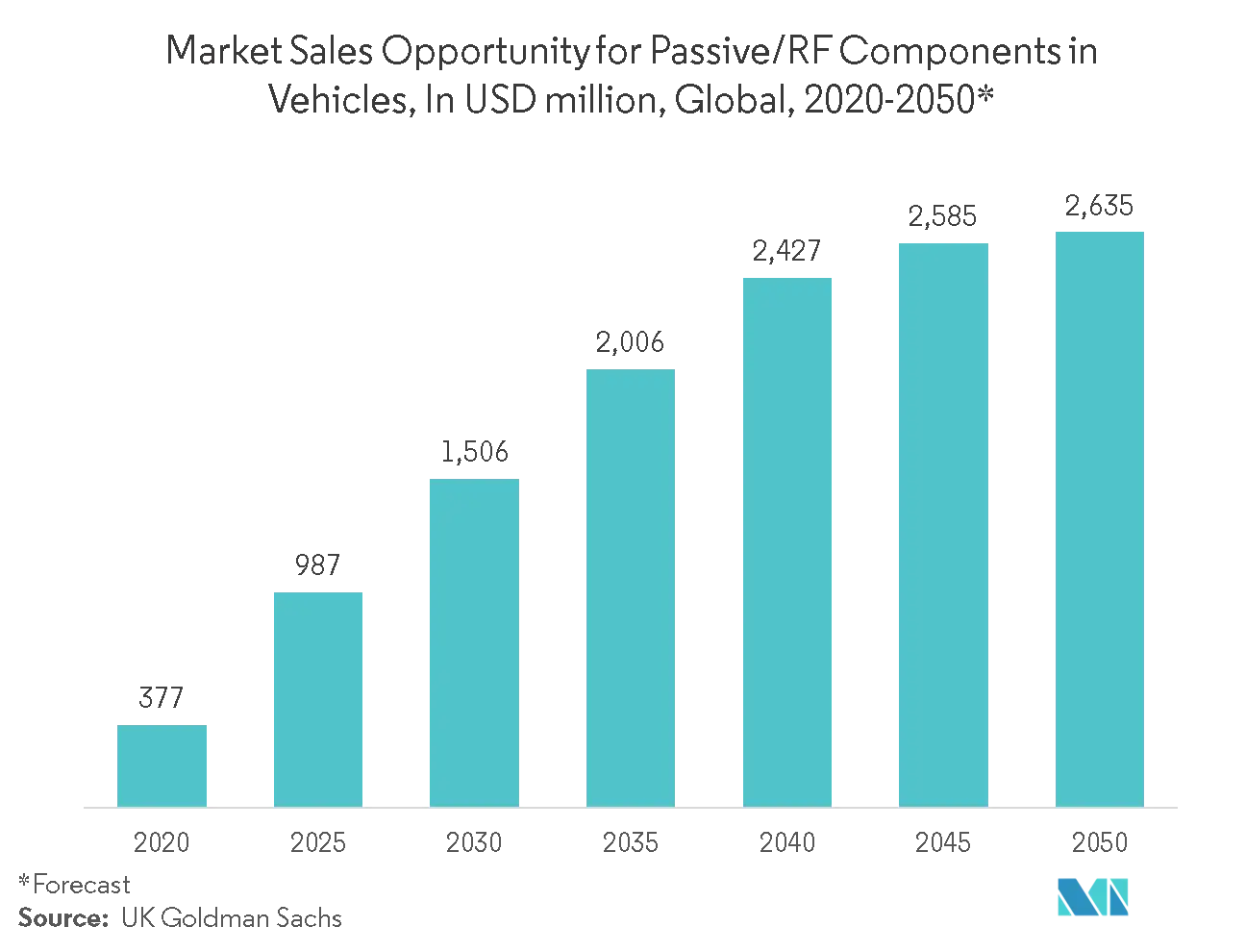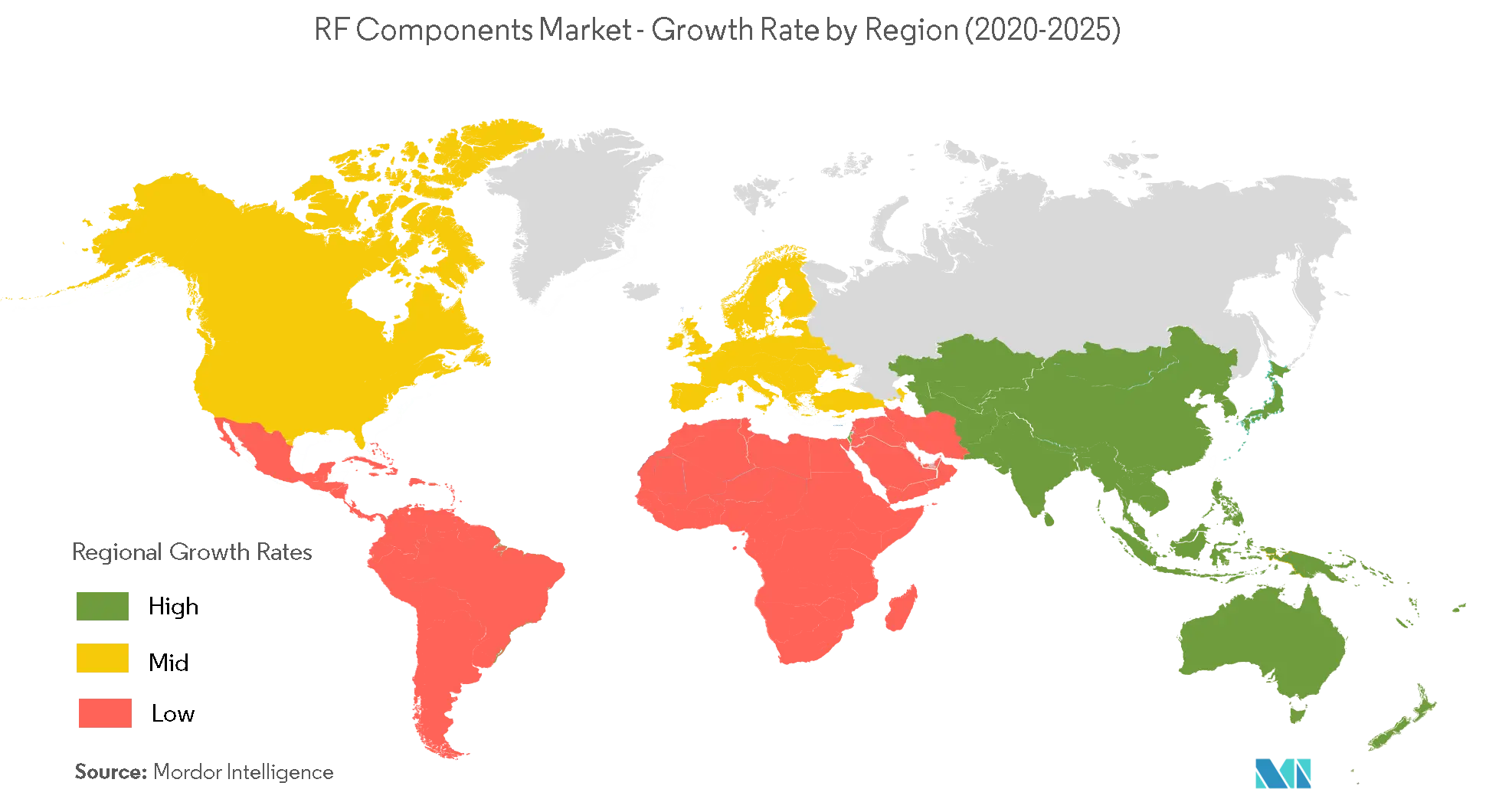Market Trends of RF Components Industry
This section covers the major market trends shaping the RF Components Market according to our research experts:
Automotive Sector to Hold Significant Growth
- Sophisticated RF electronic components in automobiles resulted in much safer, efficient, and connected vehicles. Radio was the birthplace of wireless RF integration with the automotive industry and remains one of RF design’s critical roles within the industry today. Further, the explosion of RF-based vehicle systems is not just restricted to passenger-oriented functionality. The number of RF-based subsystems in a vehicle is used for features like tire pressure monitoring, remote keyless entry, software updates, etc.
- Further, automotive radar today often takes the form of a module containing an RF board and a signal processing board. The typical vehicular radar module contains five major functional building blocks, which are antenna, the RF section, a high-speed digital interface, a signal processor, and a power section. The instance is the RDK-S32R274 module from NXP Semiconductors NV. It typically assists as a radar development platform and can also be used for tasks, such as collision avoidance, adaptive cruise control, and occupancy detection.
- Furthermore, according to Goldman Sachs, the market for ADAS is estimated to increase to USD 96 billion in 2025 from USD 3 billion in 2015. Reducing measurement time will be instrumental in bringing affordable ADAS vehicles to market integrated with RF components. In May 2019, Infineon announced to expand its development sites in Linz and Graz, Austria. The company’s new RF development center in Linz will be involved in developing new RF components such as radar ICs for automobiles, with its main focus on 77-GHz radar chips for advanced driver-assistance systems (ADAS).
- Recently companies have also focused on the development of 5G communication modules, which are a vital component of autonomous vehicles (AVs). However, using 5G technology for communication modules for automotive deployment is not easy because it uses high-frequency bands, causing higher loss of signals than LTE (Long Term Evolution, 4G mobile telecommunication technology), as well as high heat generation due to transmission of larger amounts of data.
- To address this problem, LG Innotek used its proprietary RF circuit design technology, high precision, and density modularized technology, as well as heat resistant new materials. In October 2019, LG Innotek was the first company to develop a 5G cellular communication module for automotive applications using Qualcomm chips that can be installed in or on vehicles for V2X. The module combines a communication chip, memory, and RF (radio frequency) circuit.
- Further players are also doing mergers and acquisitions to expand their RF components solutions. In January 2019, Taoglas announced the completion of its acquisition of ThinkWireless, Inc.(antenna provider). With the acquisitions, Taoglas Group looks to further expand into new, synergistic markets such as the commercial vehicle industry, helping to grow presence in trucking, bus, off-road, and motorcycle industry trucking.

Asia-Pacific to Witness Significant Growth
- Asia-Pacific is expected to witness significant growth. The advancement in consumer electronics and growing defense equipment requirements with the substantial growth in major emerging economies, such as China, India, and South Korea, will further boost the demand for RF component market.
- The main phone manufacturers differentiate from each other in the RF field by adopting either an integrated or a discrete approach for the RF Front-End Modules. Chinese players such as Unisoc RDA, Airoha, Richwave, Goertek Inc., Smarter Micro, Huntersun, and Maxscend are scoring more and more design wins amongst the Chinese OEM brands. This enables them to integrate with more agreement with other players.
- In April 2019, MACOM Technology Solutions Holdings, Inc. announced that it has agreed to establish a joint venture company with Goertek Inc. (OEMs and service providers). The joint venture company will be based in Hong Kong and will supply, market, and distribute GaN-on-Si based RF Power components into China’s base station market. Goertek will provide total consideration to MACOM of up to USD 134.6 million, including USD 30 million upfront.
- Increasing the production of vehicles in Asia-Pacific is expected to drive the demand for GaN, which in turn, may boost the market for RF power in the region. China is the largest maker of electric vehicles. China leads with the highest level of EV uptake over the projection period, where the share of EVs in new vehicle sales is estimated to reach 57% across all road transport modes (i.e., two-wheelers, cars, buses, and trucks) till 2030.
- Further, according to IBEF, 2019, the Indian appliance and consumer electronics (ACE) market reached Rs 2.05 trillion (USD 31.48 billion) in 2017 and is expected to grow at 41% CAGR between 2017-20 to reach USD 400 billion. This further holds the expected demand for RF transceiver and the antenna, comprised mostly of components like power amplifiers (PAs), low noise amplifiers (LNAs), switches, duplexers, filters, and other passive devices which penetrates the market growth.
- Further, players are focused on mergers and acquisitions to expand the business of RF components. In February 2020, Apollo Micro Systems, India (caters primarily to defense and aerospace sectors) announced to acquire a majority stake in Ananya SIP RF Technologies (ASIP RF). The company signed an agreement acquiring 51 percent equity share capital, where the company aims to expand the business towards new technologies by establishing a radio frequency (RF) and microwave design-cum-production facility along with the integration facility.


